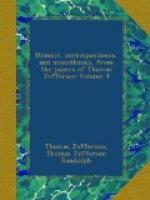live on the interest. He therefore gives it to
A, in exchange for A’s certificates of public
stock. Now, then, A has the money to employ in
business, which B so employed before. B has the
money on interest to live on, which A lived on before:
and the public pays the interest to B, which they paid
to A before. Here is no new creation of capital,
no additional money employed, nor even a change in
the employment of a single dollar. The only change
is of place between A and B, in which we discover no
creation of capital, nor public blessing. Suppose,
again, the public to owe nothing. Then A not
having lent his money to the public, would be in possession
of it himself, and would go into business without the
previous operation of selling stock. Here again,
the same quantity of capital is employed as in the
former case, though no public debt exists. In
neither case is there any creation of active capital,
nor other difference than that there is a public debt
in the first case, and none in the last; and we may
safely ask which of the two situations is most truly
a public blessing? If, then, a public debt be
no public blessing, we may pronounce a fortiori,
that a private one cannot be so. If the debt
which the banking companies owe be a blessing to any
body, it is to themselves alone, who are realizing
a solid interest of eight or ten per cent, on it.
As to the public, these companies have banished all
our gold and silver medium, which, before their institution,
we had without interest, which never could have perished
in our hands, and would have been our salvation now
in the hour of war; instead of which, they have given
us two hundred millions of froth and bubble, on which
we are to pay them heavy interest, until it shall
vanish into air, as Morris’s notes did.
We are warranted, then, in affirming that this parody
on the principle of ‘a public debt being a public
blessing,’ and its mutation into the blessing
of private instead of public debts, is as ridiculous
as the original principle itself. In both cases,
the truth is, that capital may be produced by industry,
and accumulated by economy: but jugglers only
will propose to create it by legerdemain tricks with
paper. I have called the actual circulation of
bank paper in the United States, two hundred millions
of dollars. I do not recollect where I have seen
this estimate; but I retain the impression that I thought
it just at the time. It may be tested, however,
by a list of the banks now in the United States, and
the amount of their capital. I have no means of
recurring to such a list for the present day:
but I turn to two lists in my possession for the years
of 1803 and 1804.
In 1803, there were thirty-four banks, whose capital was $28,902,000
In 1804, there were sixty-six, consequently thirty-two additional ones. Their capital is not stated, but at the average of the others (excluding the highest, that of the United States, which was of ten millions) they would be of six hundred thousand dollars each, and add.........19,200,000




